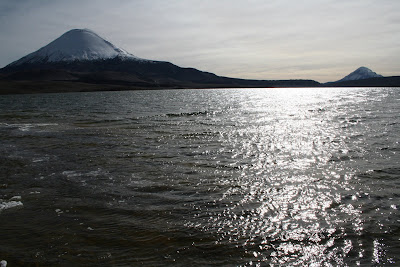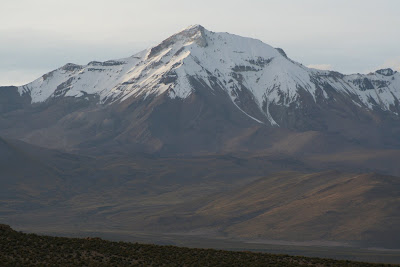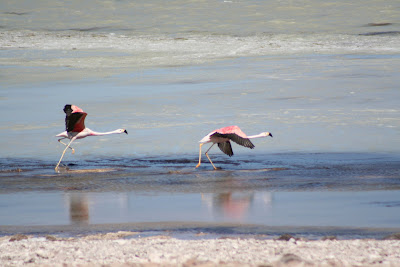Early on Tuesday morning we set off in our 4wd pickup over rough tracks through the Isluga national park. Isluga is an active volcano, but today she had given up smoking.
Throughout this area are Aymara villages. Most of which are no longer permantly lived in, as the population has moved down to the northern coastal cities. They only return for festivals, weddings and funerals. The villages are lovely though, all with adobe churches dating back to the 18th century. The first village we reached was Isluga itself.

Our drive north continued, bumping along the rough piste track, past Rheas and Vicuñas.

We were warned we had to ford a river, that given the early hour would be frozen solid. We were not the first to arrive at this spot. Three Germans who had hired their own pickup, were stuck there, wondering how to cross. The key to fording these frozen rivers is to break the ice first, as the sharp ice can puncture the engines cooler system. So watched by inquisitive Alpachas, we started to break the ice, but were unable to break the ice in the mid stream. So using the German's pickup we reversed it into the stream, with me hacking at the ice. I noticed they only had their bags in the back of their pick up. No extra fuel!! I wonder where they came to grief, for we carried two extra huge fuel containers!

Next stop was the Salar De Surire. Here I knocked off another animal from my list of ones to sea. The Vizchacha (SP??) is a rabbit like mammal with a long fluffy tail. They didn't seem shy and I could get quite close before they rock hopped away.


The Salar was, as with others, quite stunning. These together with the volcanoes make the Aliplano such a unique landscape. Despite the altitude and cold, the highlands are alive with colour. This plant's green is astonishing.

Lunch was at the borax plant, and was needed as it was still mightily cold up here.

Moving north the twin volcanoes of Parinacota and Pomerape started to become visible, once we reached the active peak of Guiltire.

Here's a pic of a frustrated bellringer!

Arriving in Parinacota, we waited by a lake for the sunset over the twin volcanoes. These volcanoes are one of the biggest reasons for choosing South America. Years ago I saw pictures of them, and then had to search and search to find out eventually that they were in Lauca national park, Chile.

The night was spent in a very cold room, without electricity. But the Llama steak was great.























































